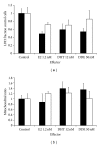Alterations in sensitivity to estrogen, dihydrotestosterone, and xenogens in B-lymphocytes from children with autism spectrum disorder and their unaffected twins/siblings
- PMID: 24363669
- PMCID: PMC3836453
- DOI: 10.1155/2013/159810
Alterations in sensitivity to estrogen, dihydrotestosterone, and xenogens in B-lymphocytes from children with autism spectrum disorder and their unaffected twins/siblings
Abstract
It has been postulated that androgen overexposure in a susceptible person leads to excessive brain masculinization and the autism spectrum disorder (ASD) phenotype. In this study, the responses to estradiol (E2), dihydrotestosterone (DHT), and dichlorodiphenyldichloroethylene (DDE) on B-lymphocytes from ASD subjects and controls are compared. B cells were obtained from 11 ASD subjects, their unaffected fraternal twins, and nontwin siblings. Controls were obtained from a different cell bank. Lactate dehydrogenase (LDH) and sodium 2,3-bis(2-methoxy-4-nitro-5-sulfophenyl)-2H-tetrazolium-5-carboxanilide (XTT) reduction levels were measured after incubation with different concentrations of E2, DHT, and DDE. XTT/LDH ratio, representative of mitochondria number per cell, was calculated. E2, DHT, and DDE all cause "U"-shaped growth curves, as measured by LDH levels. ASD B cells show less growth depression compared to siblings and controls (P < 0.01). They also have reduced XTT/LDH ratios (P < 0.01) when compared to external controls, whereas siblings had values of XTT/LDH between ASD and external controls. B-lymphocytes from people with ASD exhibit a differential response to E2, DHT, and hormone disruptors in regard to cell growth and mitochondrial upregulation when compared to non-ASD siblings and external controls. Specifically, ASD B-lymphocytes show significantly less growth depression and less mitochondrial upregulation when exposed to these effectors. A mitochondrial deficit in ASD individuals is implied.
Figures



Similar articles
-
B-lymphocytes from a population of children with autism spectrum disorder and their unaffected siblings exhibit hypersensitivity to thimerosal.J Toxicol. 2013;2013:801517. doi: 10.1155/2013/801517. Epub 2013 Jun 9. J Toxicol. 2013. PMID: 23843785 Free PMC article.
-
Bisphenol A induces oxidative stress and mitochondrial dysfunction in lymphoblasts from children with autism and unaffected siblings.Free Radic Biol Med. 2014 Nov;76:25-33. doi: 10.1016/j.freeradbiomed.2014.07.030. Epub 2014 Aug 4. Free Radic Biol Med. 2014. PMID: 25101517
-
Altered frontal aslant tracts as a heritable neural basis of social communication deficits in autism spectrum disorder: A sibling study using tract-based automatic analysis.Autism Res. 2019 Feb;12(2):225-238. doi: 10.1002/aur.2044. Epub 2018 Dec 12. Autism Res. 2019. PMID: 30548800
-
Broader Autism Phenotype in Siblings of Children with ASD--A Review.Int J Mol Sci. 2015 Jun 10;16(6):13217-58. doi: 10.3390/ijms160613217. Int J Mol Sci. 2015. PMID: 26068453 Free PMC article. Review.
-
Decreased left perisylvian GABA concentration in children with autism and unaffected siblings.Neuroimage. 2014 Feb 1;86:28-34. doi: 10.1016/j.neuroimage.2013.01.045. Epub 2013 Jan 28. Neuroimage. 2014. PMID: 23370056 Free PMC article. Review.
Cited by
-
Signaling Pathways and Sex Differential Processes in Autism Spectrum Disorder.Front Psychiatry. 2021 Oct 8;12:716673. doi: 10.3389/fpsyt.2021.716673. eCollection 2021. Front Psychiatry. 2021. PMID: 34690830 Free PMC article. Review.
References
-
- CDC. Autism Spectrum Disorders (ASDs) in: C.f.D.C.a. Prevention, (Ed.), US Government, 2009.
-
- CDC. Prevalence of autism spectrum disorders—autism and developmental disabilities monitoring network, 14 sites, United States, 2002. MMWR. Surveillance Summaries: Morbidity and Mortality Weekly Report. Surveillance Summaries. 2007;56:12–28. - PubMed
-
- Rutter M, Caspi A, Moffitt TE. Using sex differences in psychopathology to study causal mechanisms: unifying issues and research strategies. Journal of Child Psychology and Psychiatry and Allied Disciplines. 2003;44(8):1092–1115. - PubMed
-
- Knapp M, Romeo R, Beecham J. Economic cost of autism in the UK. Autism. 2009;13(3):317–336. - PubMed
LinkOut - more resources
Full Text Sources
Other Literature Sources
Miscellaneous

